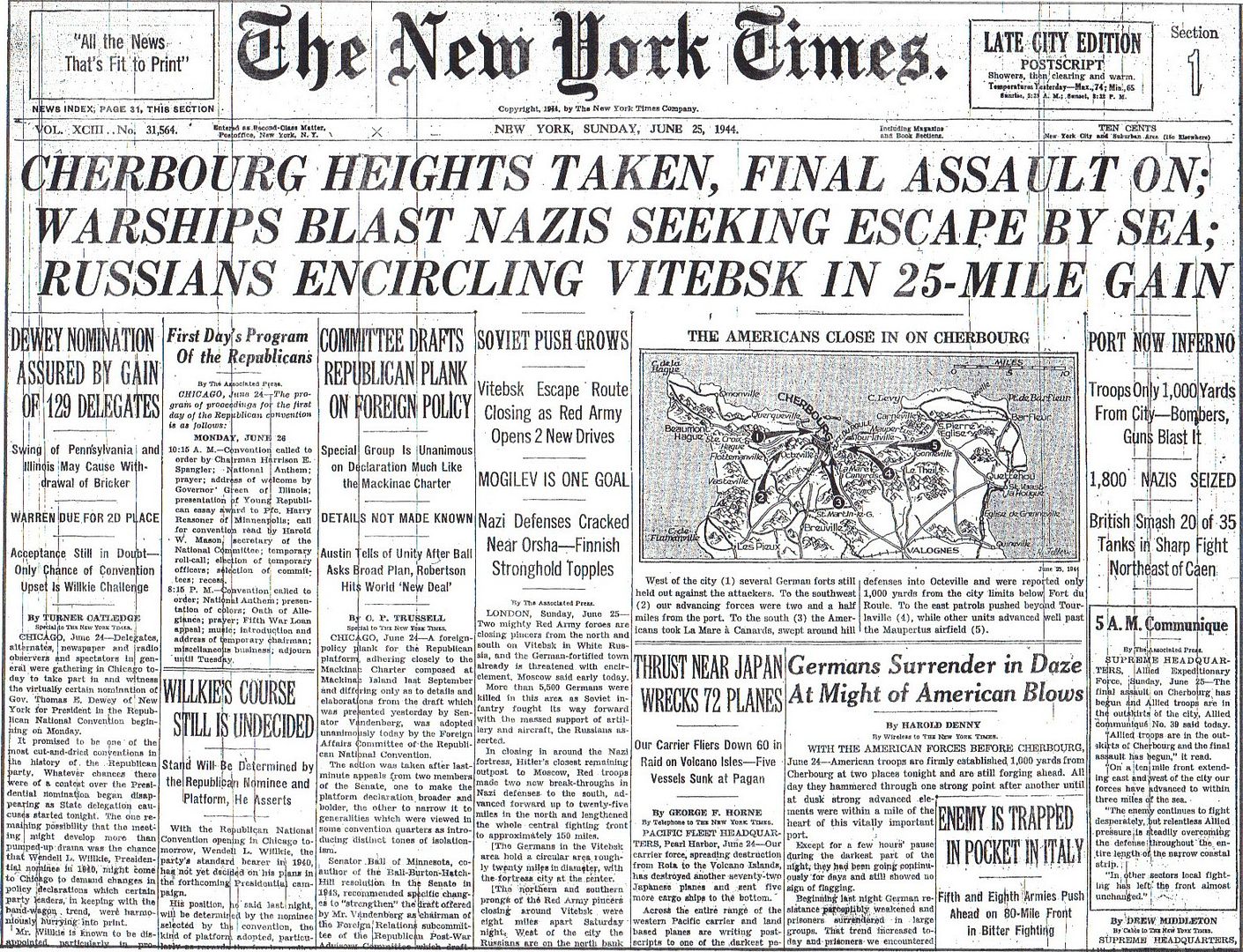
Posted on 06/25/2014 4:29:14 AM PDT by Homer_J_Simpson


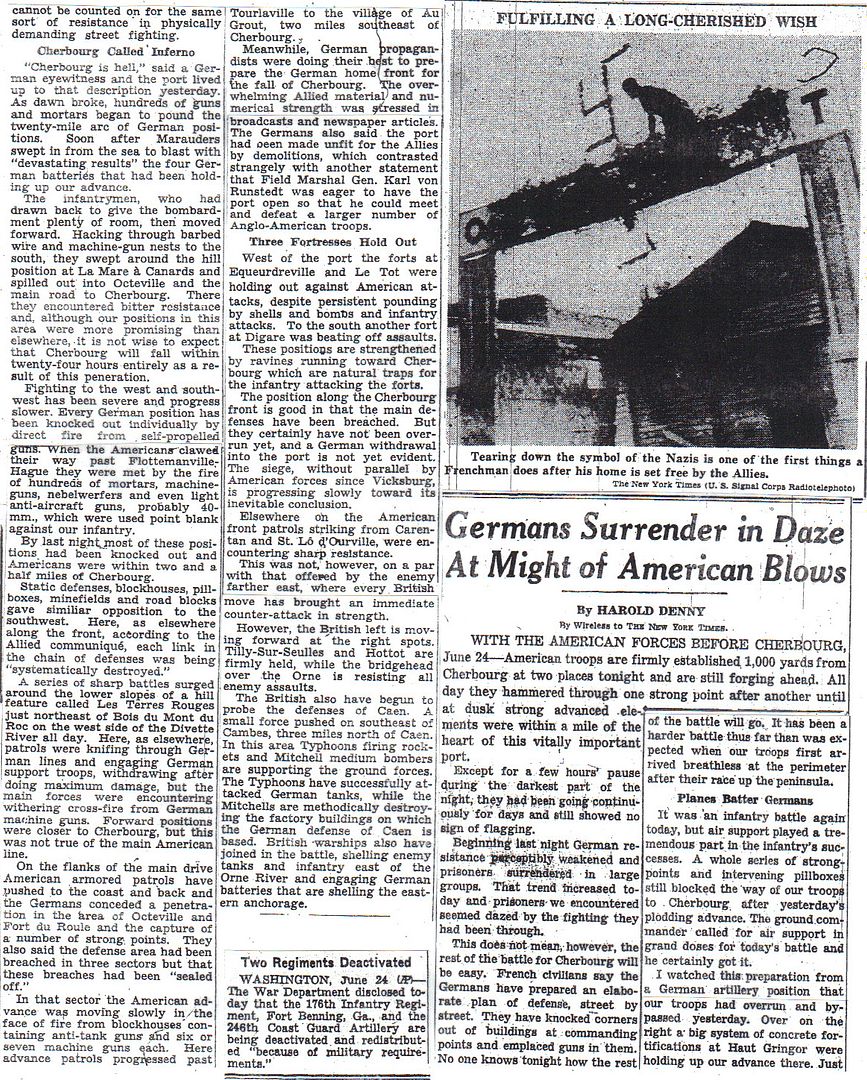
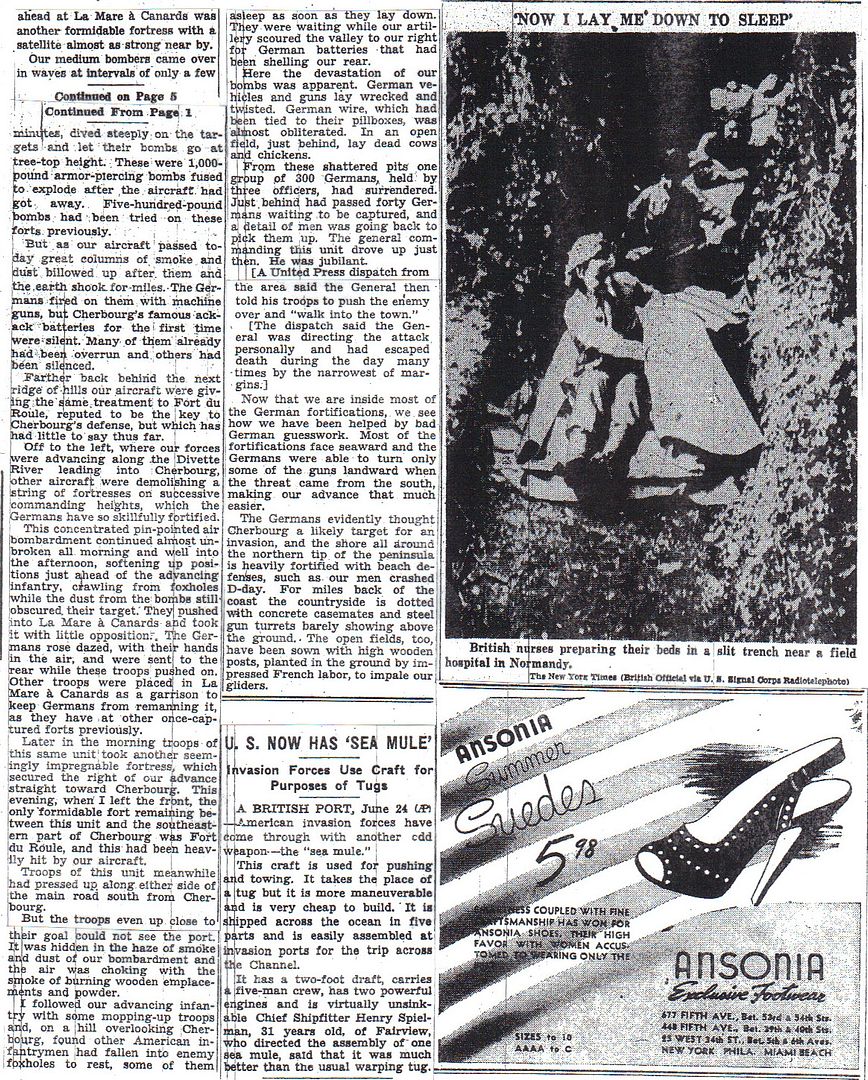
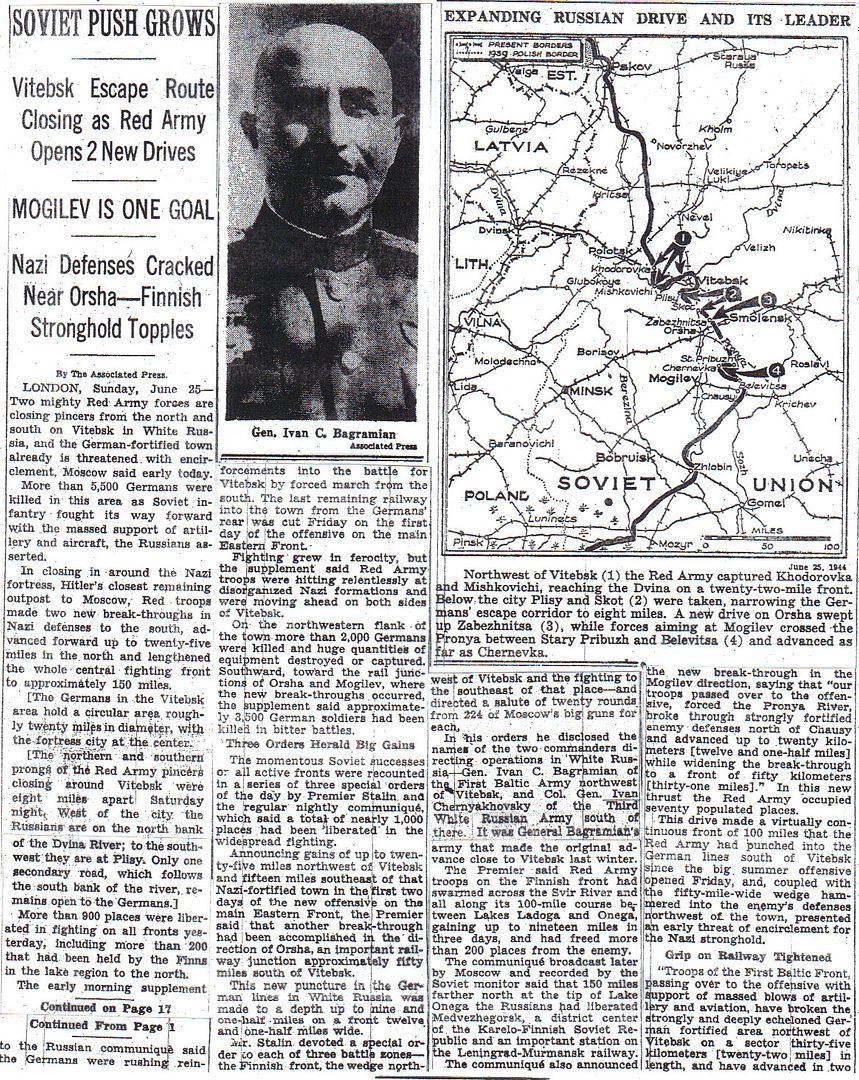

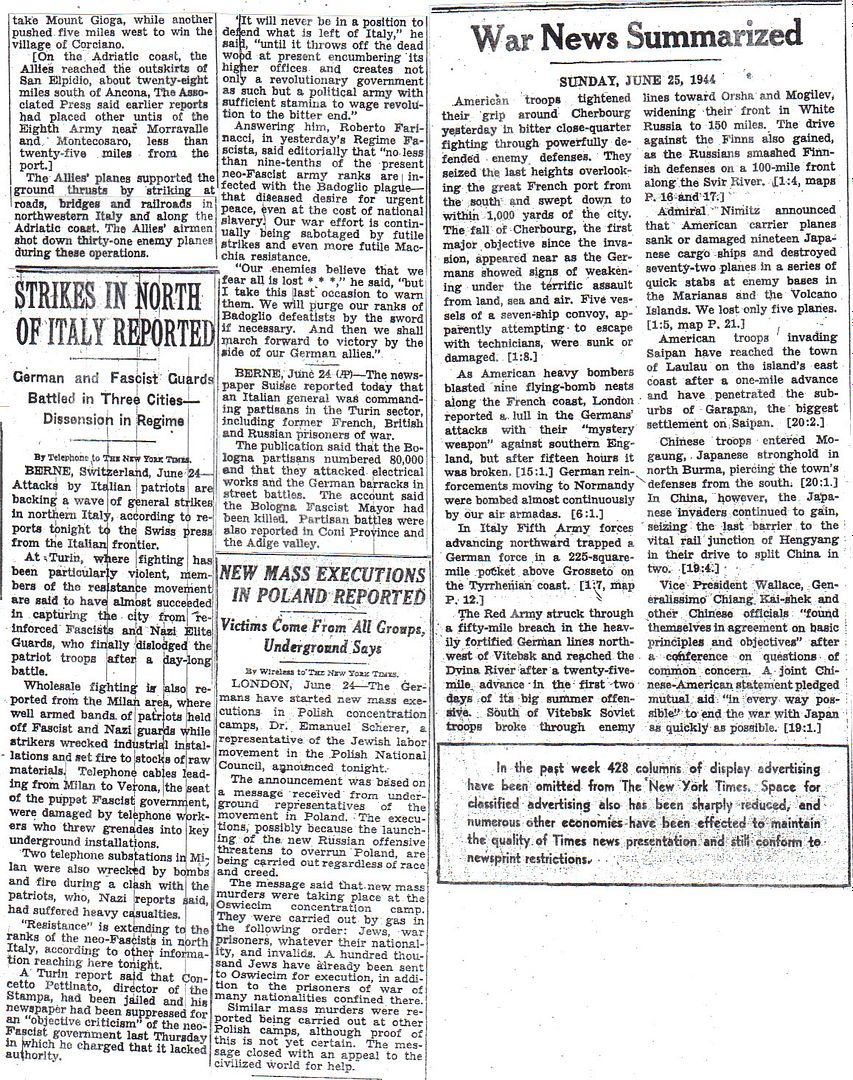
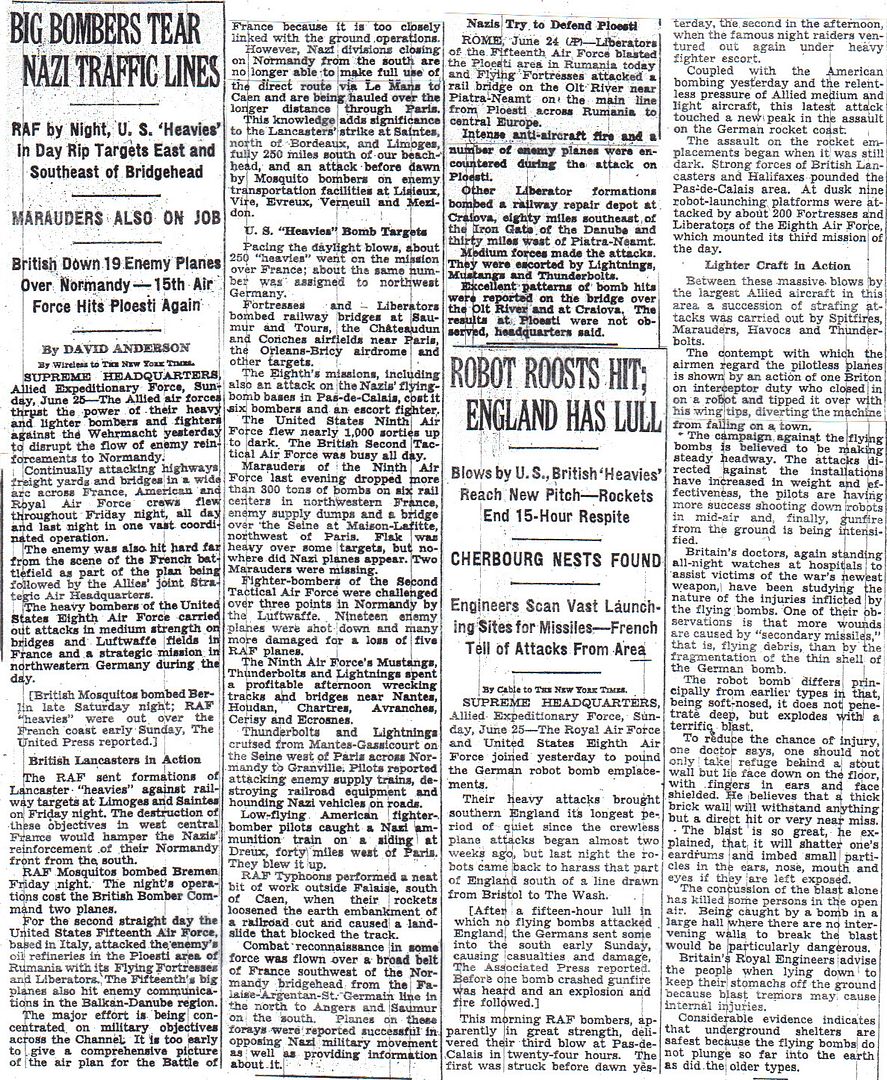
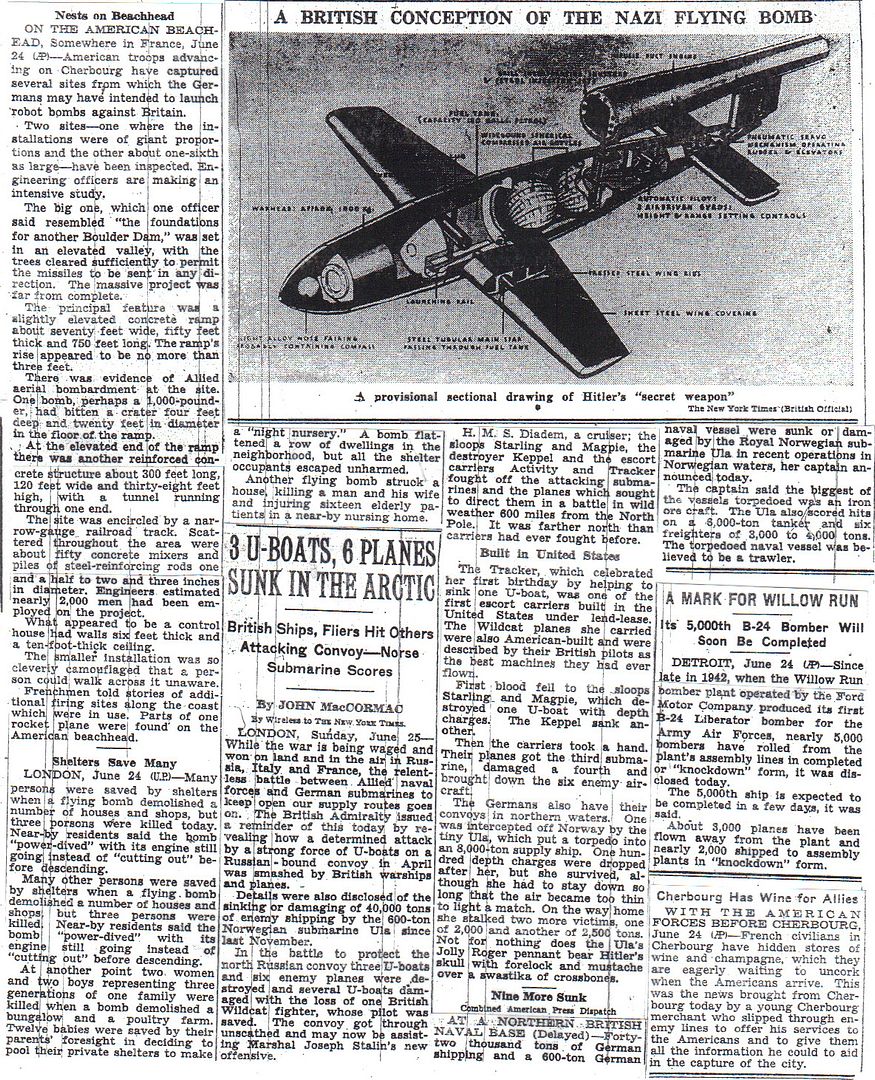
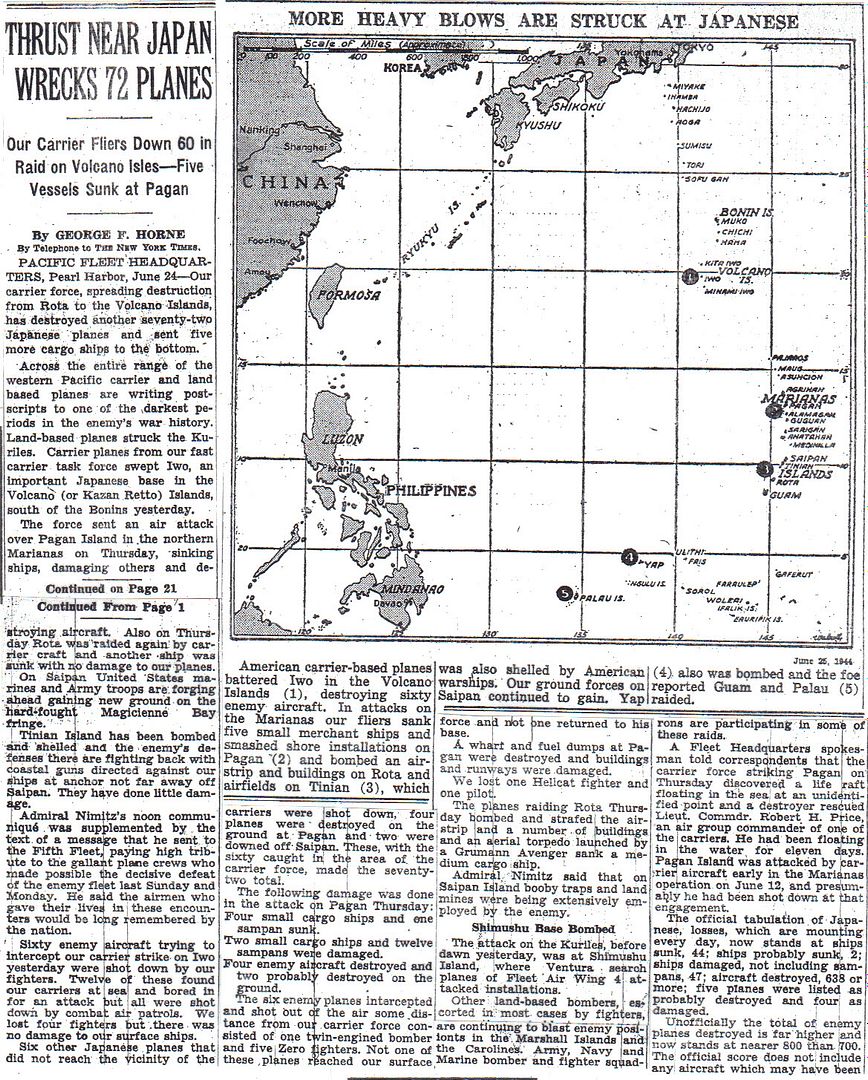
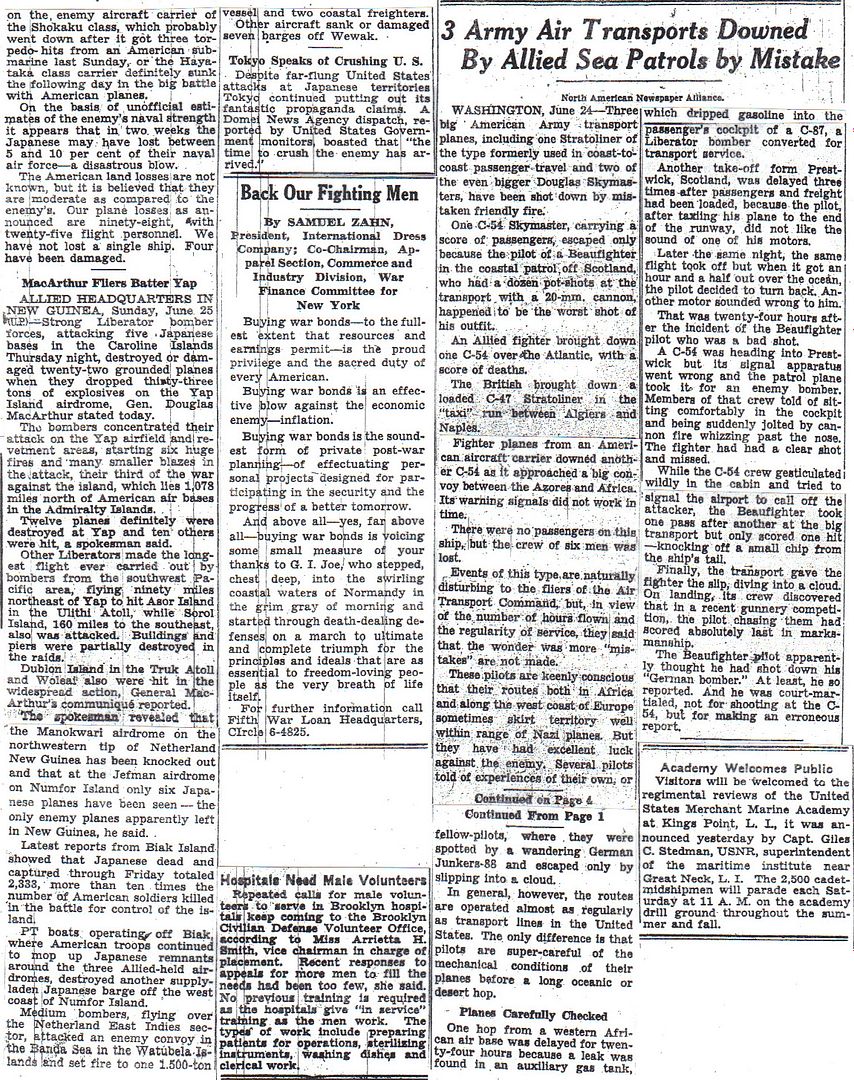
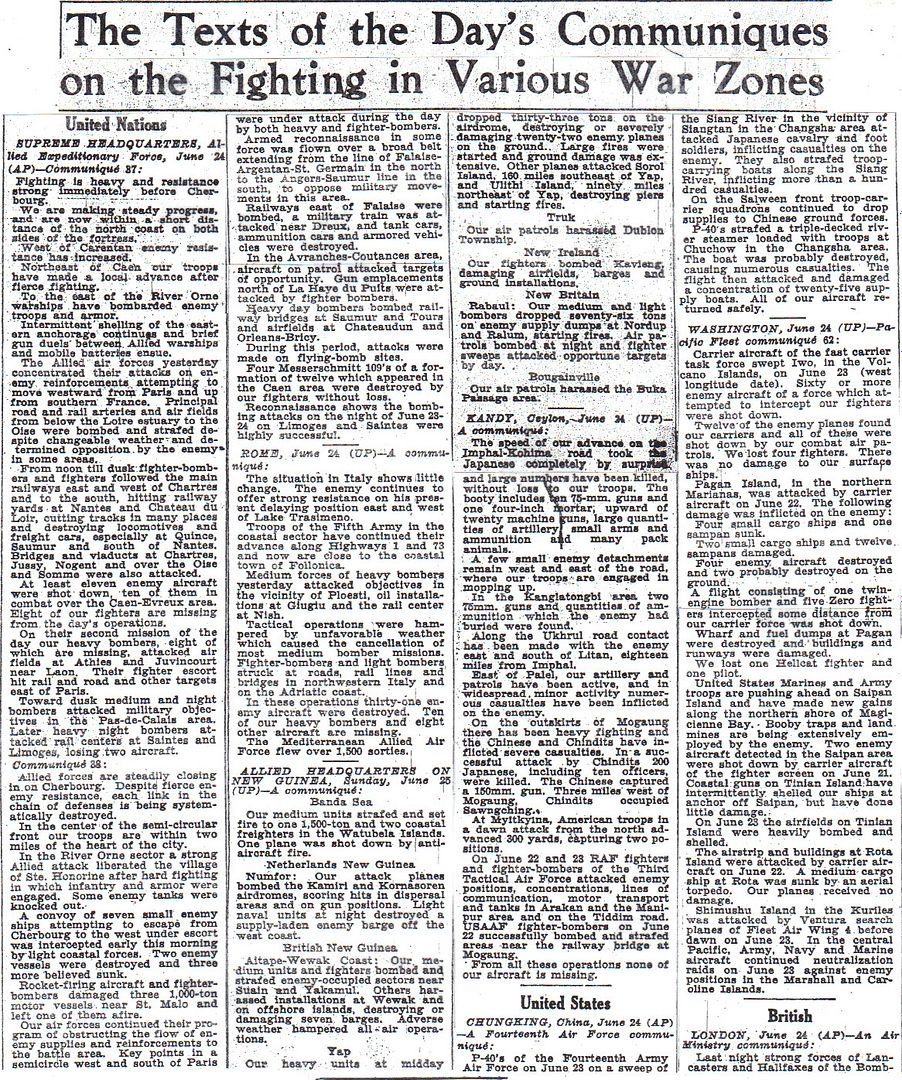
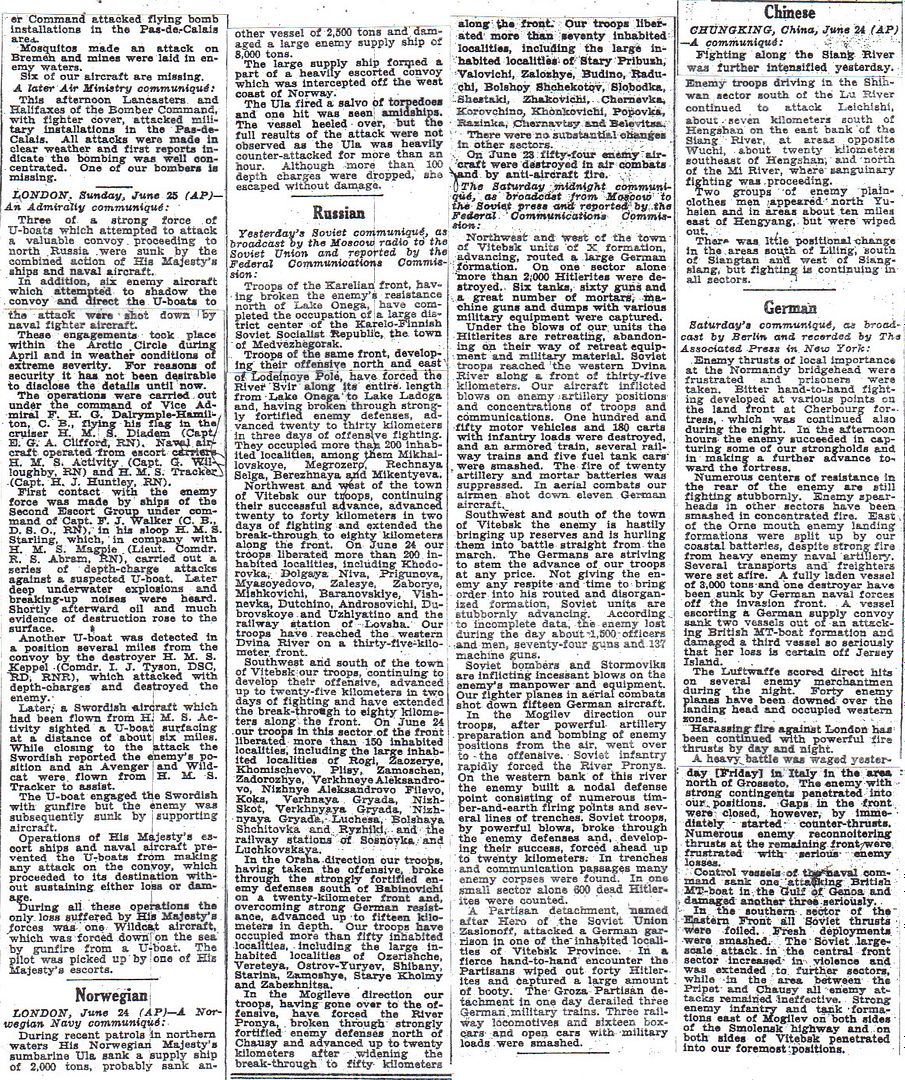
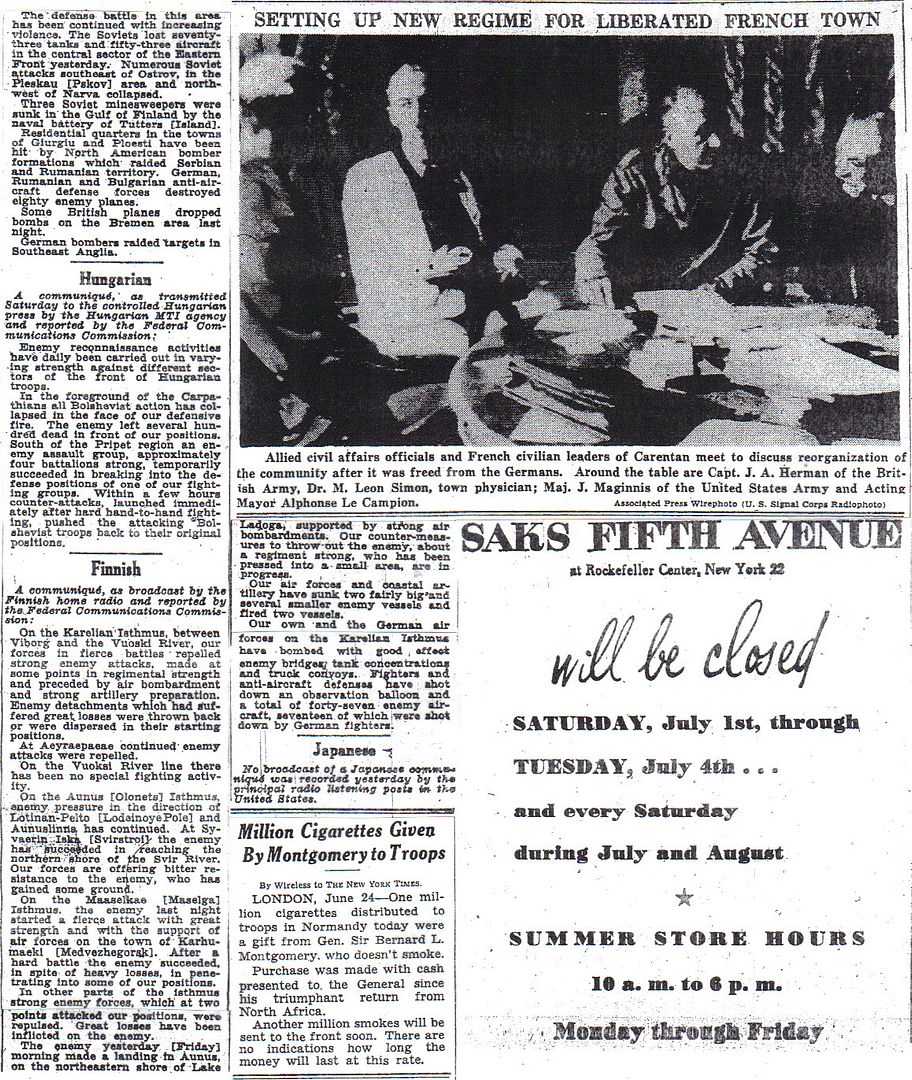
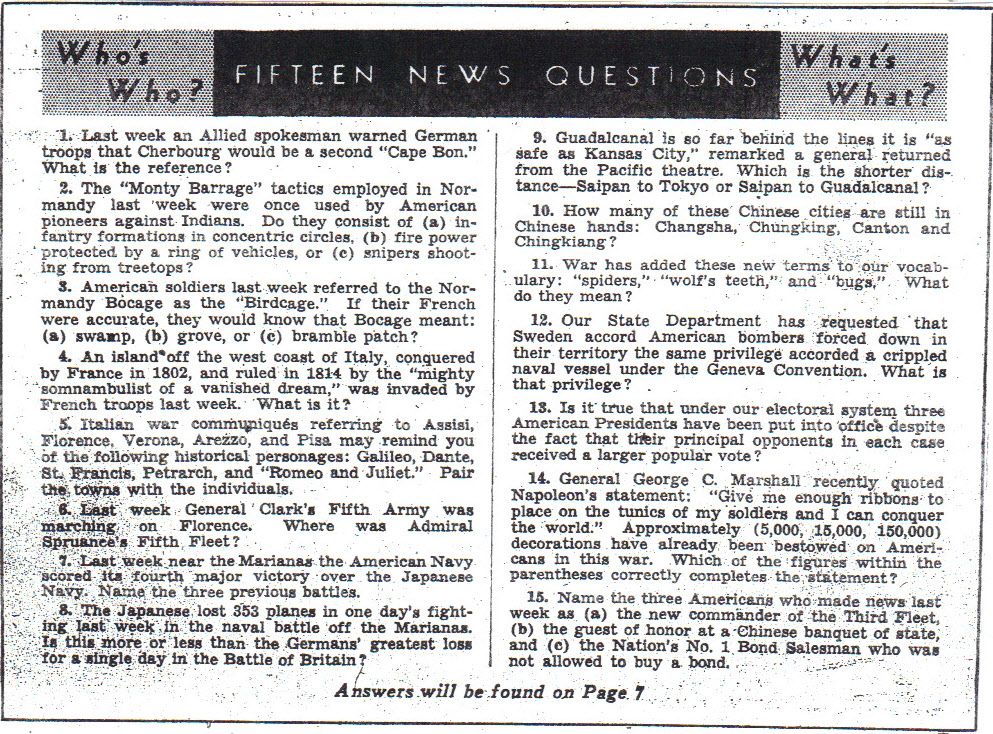
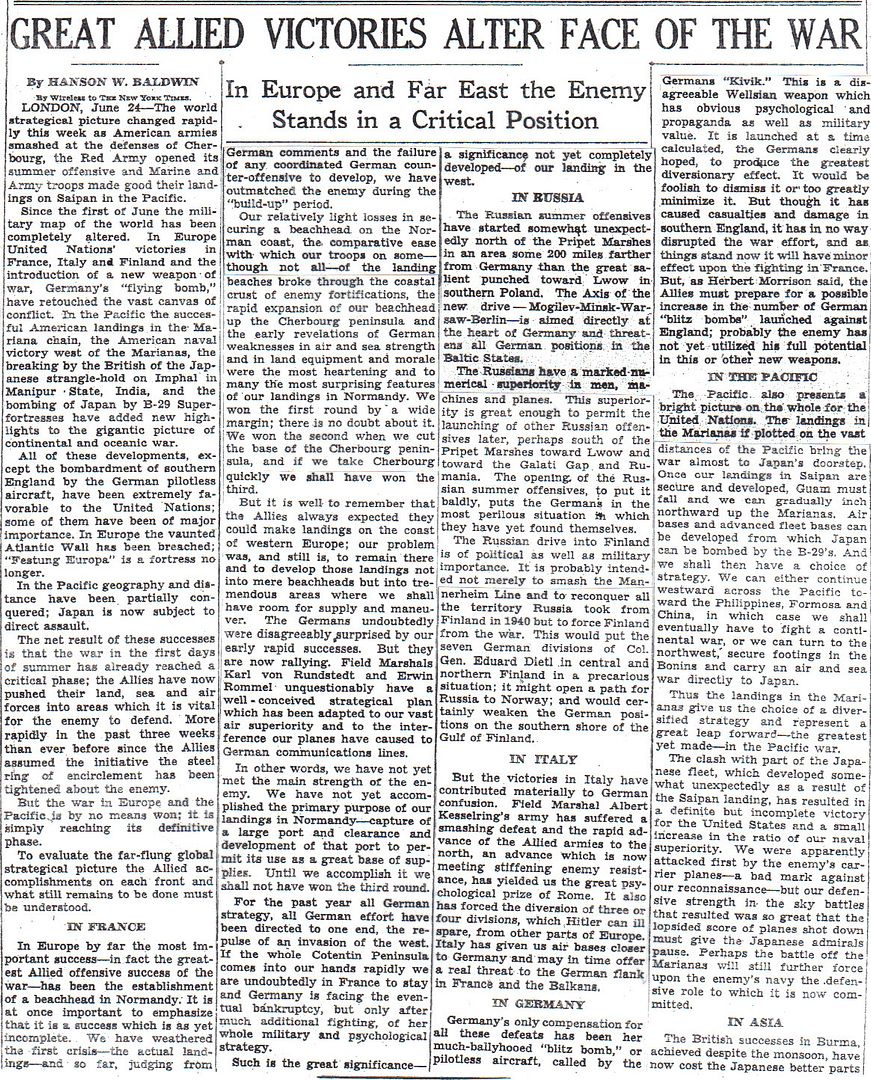
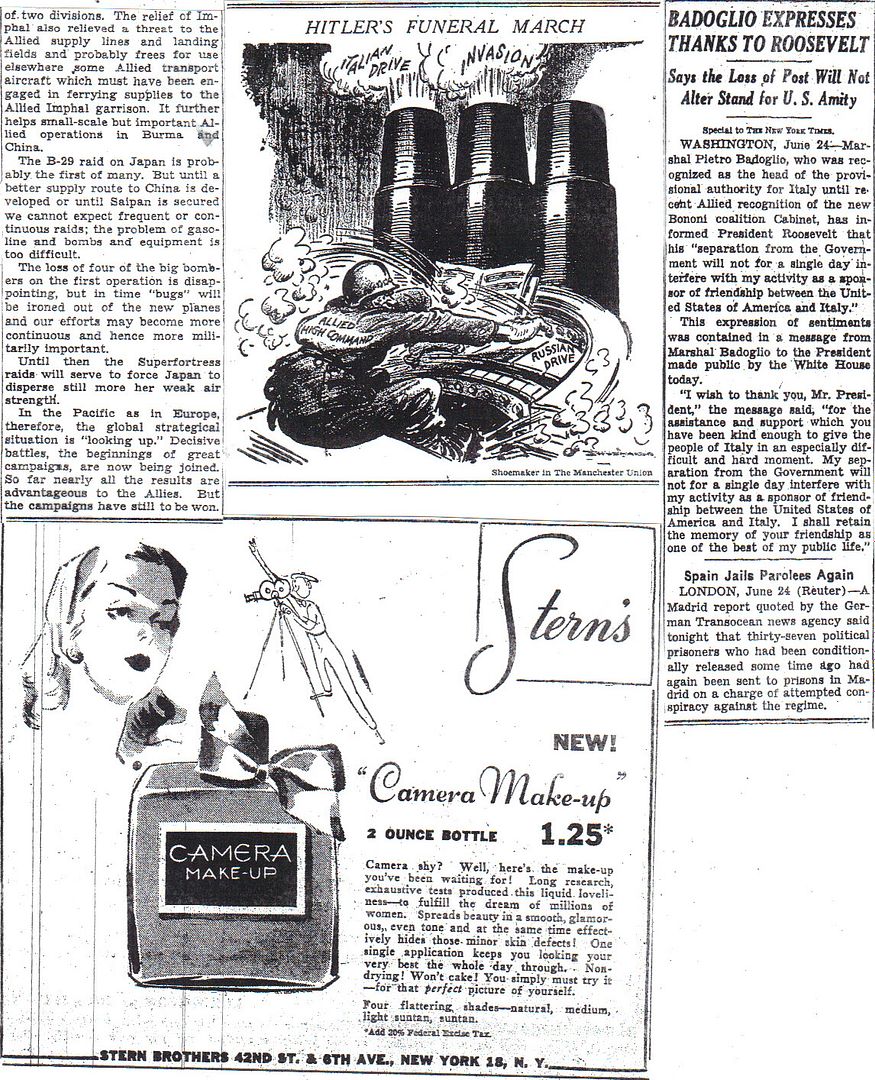

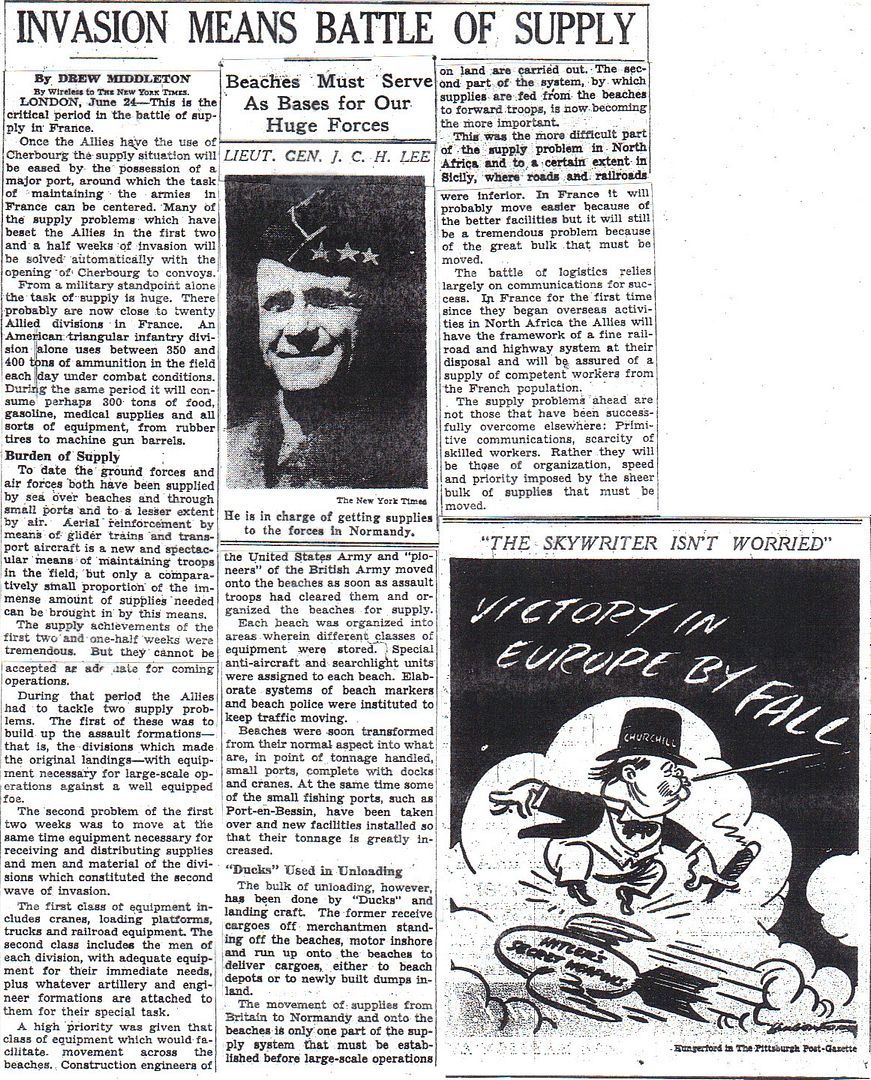
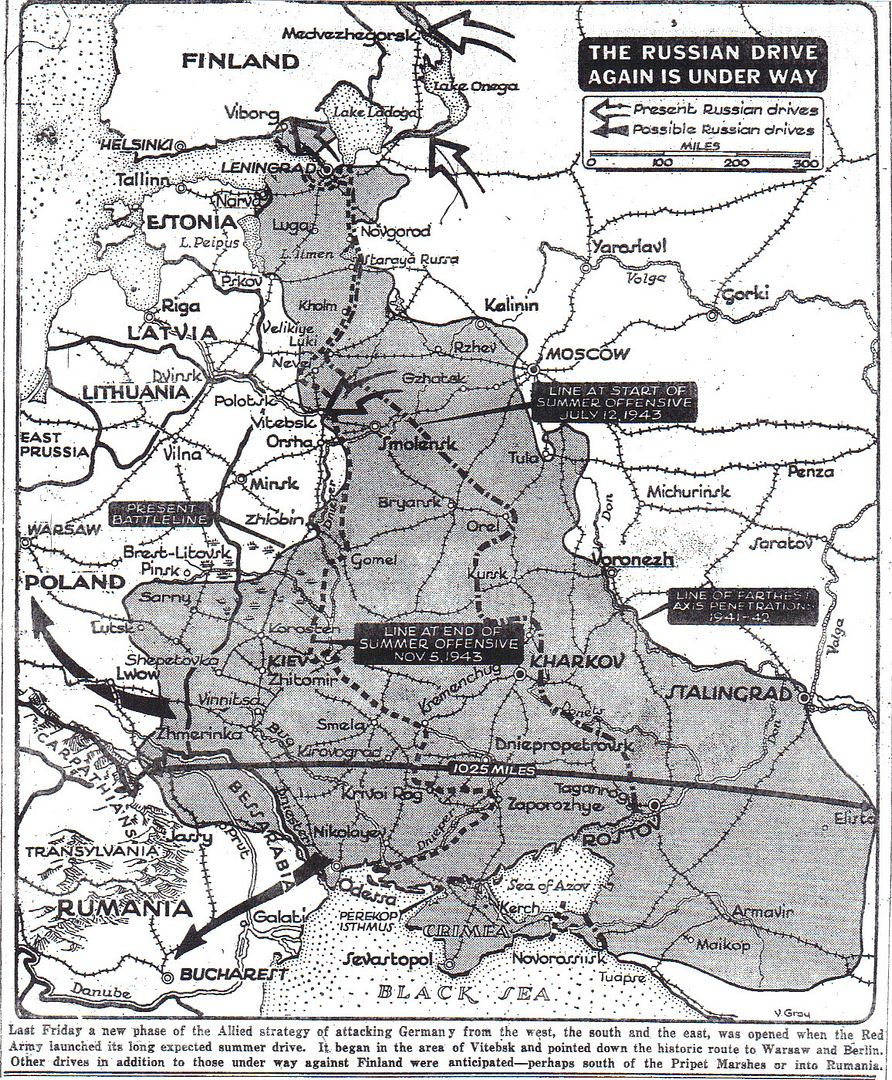
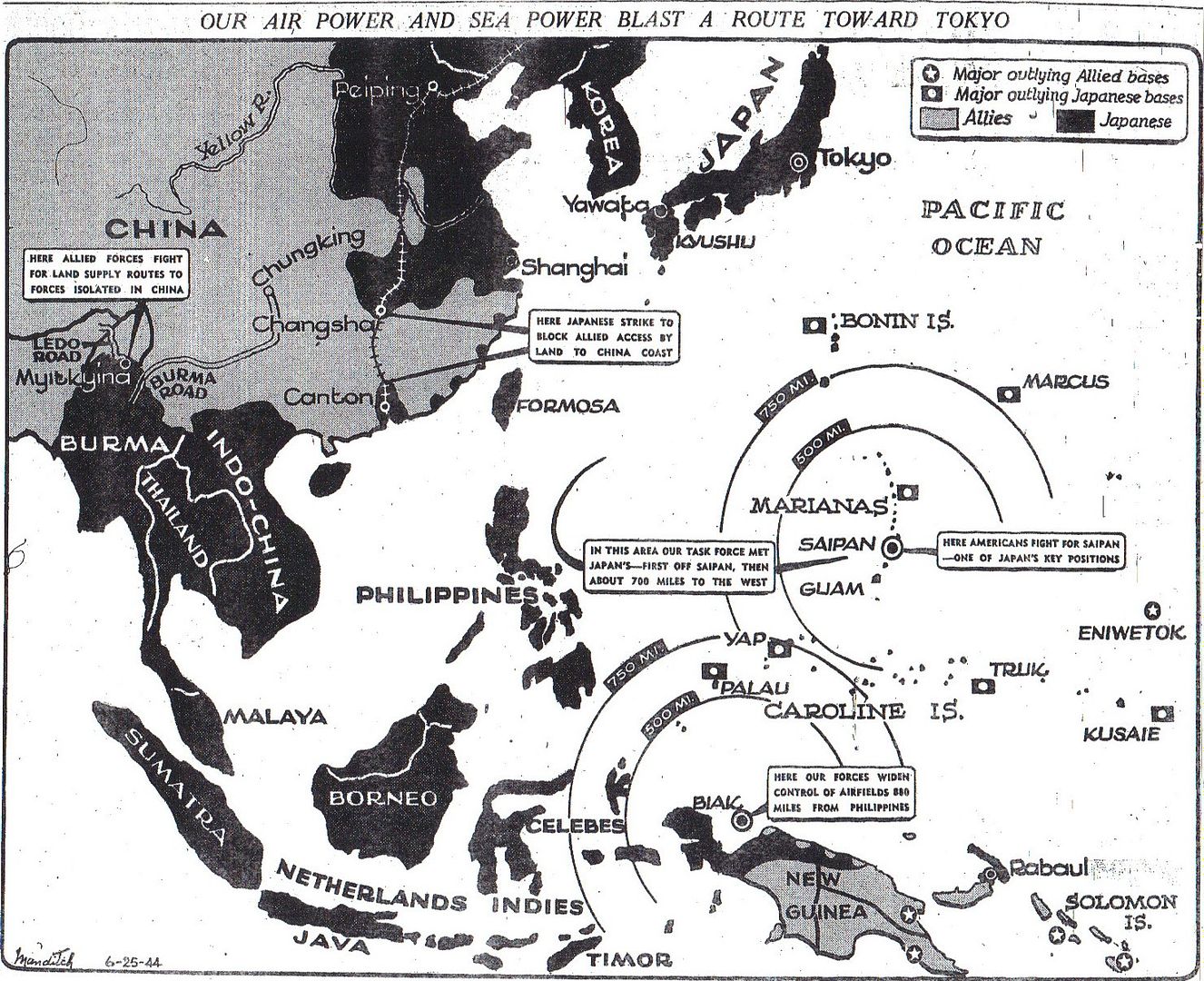
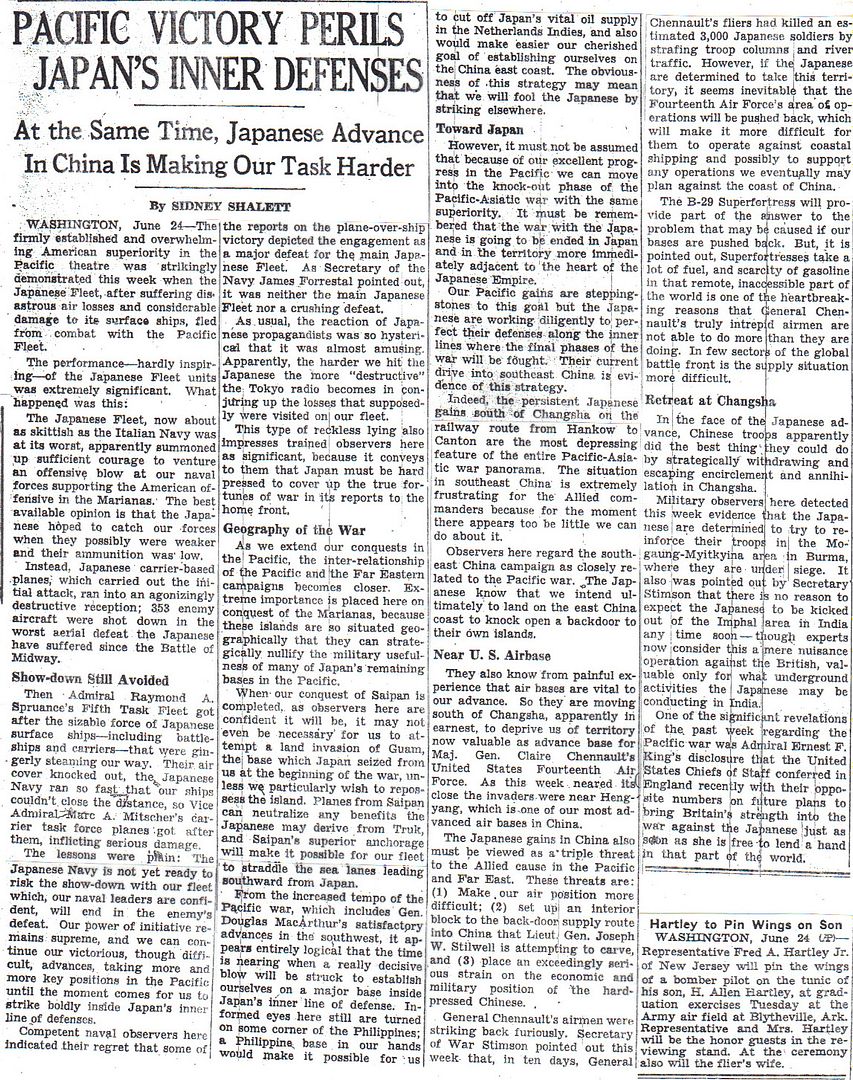
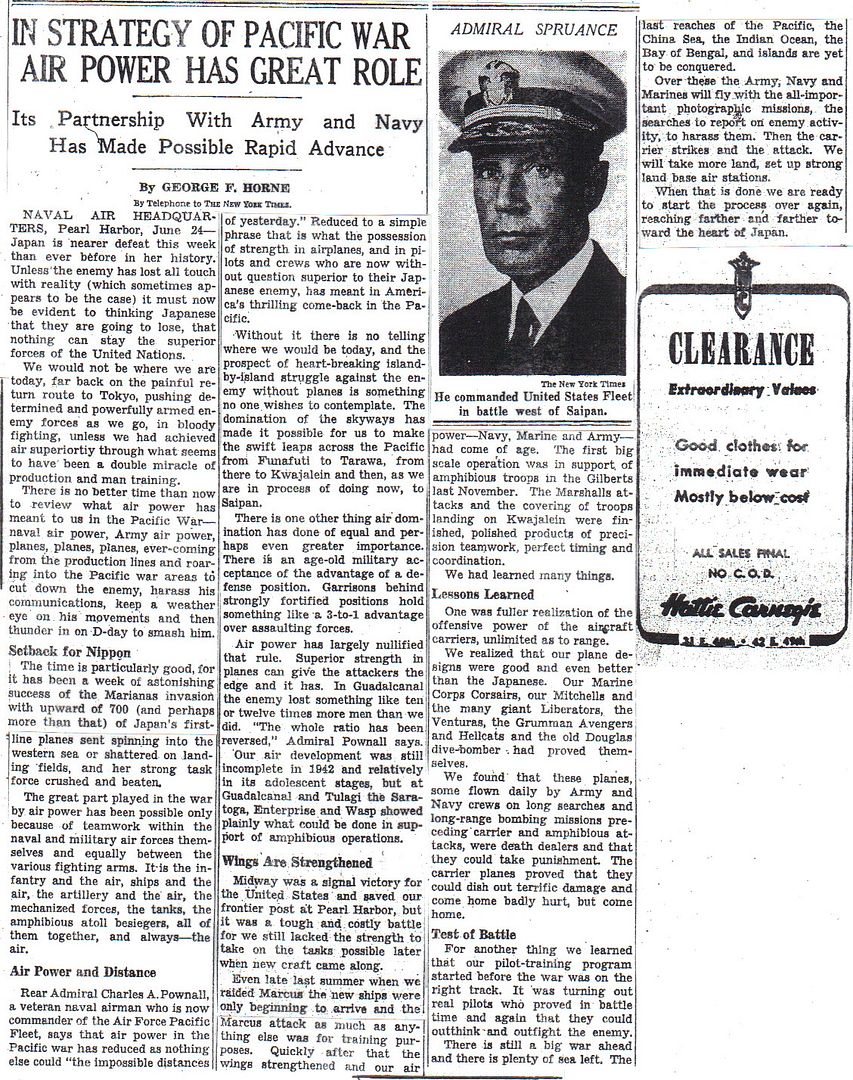
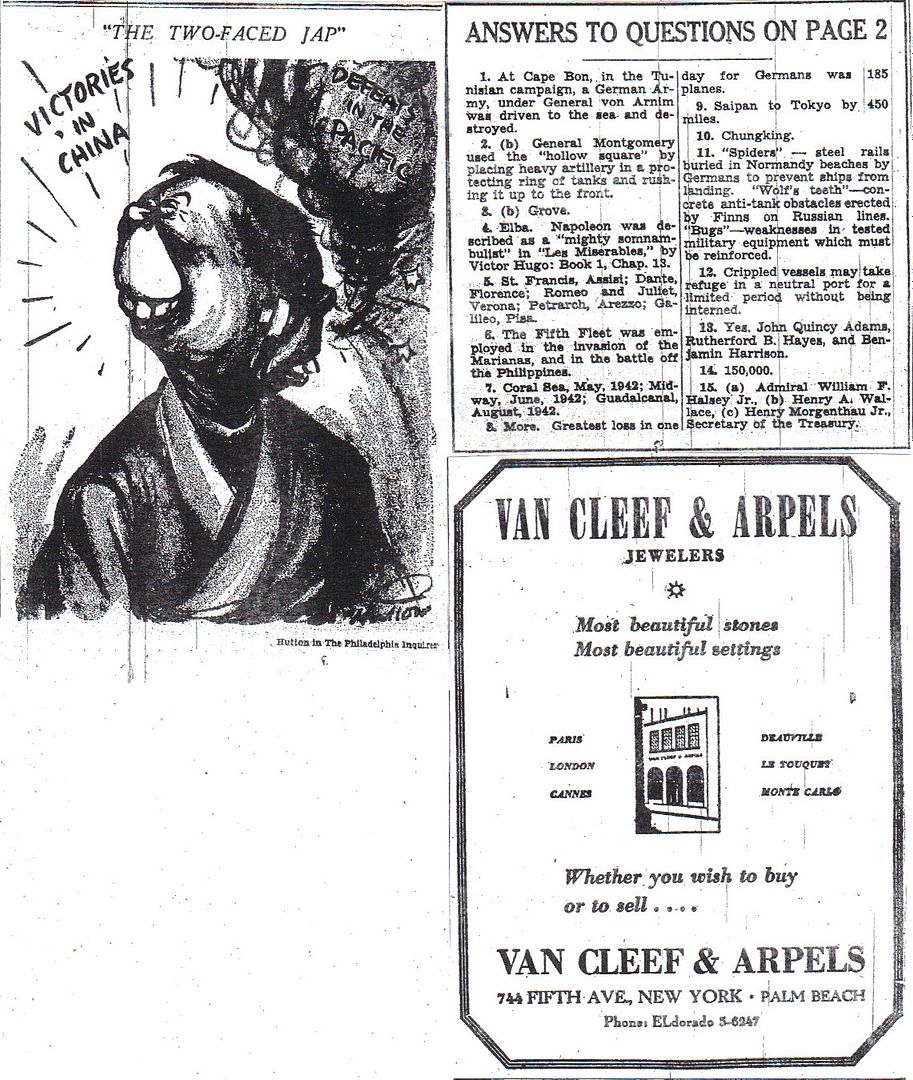
The News of the Week in Review
Fifteen News Questions – 15
Great Allied Victories Alter Face of the War (by Hanson W. Baldwin) – 16-17
Hitler’s Funeral March (cartoon) – 17
Germans’ Robot Bomb is a Potential Menace (by Raymond Daniell) – 18
Invasion Means Battle of Supply (Middleton) – 19
“The Skywriter Isn’t Worried” (cartoon) – 19
The Russian Drive Again is Under Way (map) – 20
Our Air Power and Sea Power Blast a Route toward Tokyo (map) – 21
Pacific Victory Perils Japan’s Inner Defenses (by Sidney Shalett) – 22
In Strategy of Pacific War Air Power Has Great Role (Horne) – 23
“The Two-Faced Jap” (cartoon) – 24
Answers to Fifteen News Questions – 24
http://www.onwar.com/chrono/1944/jun44/25jun44.htm#
Soviets clearing Mogilev
Sunday, June 25, 1944 www.onwar.com
Soviet armored column in Mogilev [photo at link]
On the Eastern Front... Red Army attacks on the forces of German Army Group Center continue. Soviet 1st Baltic Front and 3rd Belorussian Front complete the encirclement of Vitebsk. The German 53rd Corps (part of 3rd Panzer Army) is now trapped with 5 divisions. Other forces of 1st Baltic Front cross the Dvina River; other elements of 3rd Belorussian front approach Orsha. Forces of 2nd Belorussian Front continue to attack around Mogilev, clearing the city. The German 4th Army is being forced back. The attacks of 1st Belorussian Fronts threaten to encircle Bobruisk, trapping elements of German 9th Army.
On the Western Front... The 3 divisions of the US 7th Corps (part of US 1st Army) penetrate into the suburbs of Cherbourg. Naval support includes 3 battleships, 4 cruisers and 11 destroyers. On the left wing of the Normandy front, elements of the British 30th Corps (part of British 2nd Army) attack toward Rauray.
In Italy... Elements of US 5th Army capture Piombino. Inland the French Expeditionary Corps (part of 5th Army) and the British 8th Army attack the German-held Albert Line west of Trasimeno Lake, around Chiusi.
In the Mariana Islands... The US 5th Amphibious Corps continues to battle for Saipan. Mount Tapotchau is captured. Heavy fighting is recorded in the Hagman Peninsula and near the southwest tip of the island.
http://www.etherit.co.uk/month/thismonth/25.htm
June 25th, 1944 (SUNDAY)
UNITED KINGDOM: Frigate HMS Goodson takes a hit from a Zaunkönig fired by U-984 (Oberleutnant zur See Hans Sieder) . Her stern is blown off but she subsequently reached Portland in the tow of HMS Bligh. After survey she was not repaired. Location: English Channel, SE Start Point. (Alex Gordon)(108)
U-269 (Type VIIC) Sunk in the Channel southeast of Torquay, in position 50.01N, 02.59W, by depth charges from the British frigate HMS Bickerton. 12 dead, 39 survivors. (The wreck was located in 1951 during the search for the British submarine HMS Affray, which sank with all hands on 16 April, 1951 when her snorkel mast broke off near Alderney.) (Alex Gordon)
The U.S. Eight Air Force flies two missions from bases in England.
Mission 441: During the morning 658 bombers are dispatched to hit targets in France; seven bombers are lost:
1. Of 263 B-17s, 104 hit Francazal Airfield at Toulouse, 72 hit Blangnac Airfield at Toulouse, and 64 hit Montbartier oil depot; five B-17s are lost, one is damaged beyond repair and 114 damaged. Escort is provided by 46 P-38s, 36 P-47s and 146 P-51s; they claim 10-0-1Luftwaffe aircraft; one P-51 is lost.
2. Of 258 B-24s, 43 hit targets of opportunity, 23 hit Beuvry, 18 hit Mazingarbe, 12 hit Aube-sur-Risle, 12 hit Doullens, 12 hit La Vaupalier, 12 hit Peronne Airfield, 11 hit St Maurice Airfield at Amiens, 11 hit Calais, 11 hit Tingry, 10 hit Abbeville, 10 hit Longuenesse Airfield at St Omer, 8 hit Boulogne, 8 hit Holque, 7 hit Nunque, 7 hit Pont-a-Vendin, 2 hit Chocques; one B-24 is lost, one is damaged beyond repair and 26 damaged. Escort is provided by 68 P-47s and 34 P-51s without loss.
3. Of 137 B-24s, 59 hit St Avord Airfield and 48 hit Bourge Airfield; one B-24 is lost. Escort is provided by 102 P-38s and 44 P-47s; they claim 8-0-4 Luftwaffe aircraft without loss.
Mission 442: During the midday 463 bombers are dispatched to targets in France; six bombers are lost; escort is provided by 127 P-38s, 35 P-47s and 181 P-51s; they claim 4-0-3 Luftwaffe aircraft; one P-51 is lost.
1. Of 274 B-24s, 63 hit Villacoublay air depot, 35 hit Bretigny Airfield and 11 hit Buc Airfield; five B-24s are lost, two damaged beyond repair and 104 damaged.
2. Of 189 B-17s, 70 hit Soigny Bridge, 38 hit Sens Bridge, 28 hit Clamecy, 21 hit Auxerre Bridge, 21 hit Nanteuil, 20 hit Nogent, 18 hit Orly Airfield, 13 hit Romilly-sur-Seine, 12 hit Folous, 12 hit Mondesir Airfield at Etampes and three hit Orly marshalling yard; one B-17 is lost and 20 damaged.
41 of 43 P-47s fly a flight-bomber mission against Fauville landing ground at Evreux.
FRANCE: The US forces attacking Cherbourg have advance units of 3 divisions penetrating somewhat into the suburbs. The battle is still very intense.
Battery Hamburg (28 cm guns) on the northern shore of the Cotentin Peninsula (east of Cherbourg) duels with three USN battleships, the USS Arkansas, the USS Texas and the USS Nevada, losing only one gun out of four in the storm of 5”, 12” and 14” shells hurled at it. It scored several hits on the American ships, although the ammunition was defective and yielded a lot of duds, and, according to Samuel Eliot Morison, forced the American ships to violently manoeuvre to avoid being hit, so accurate was its firing. Like the St. Marcouf battery, it had to be reduced by ground assault. (James Allen Knechtmann)
St. Honorina, north-west of Caen, falls to the British 5th Division.
400+ USAAF Ninth Air Force B-26 Marauders and A-20 Havocs hit fuel dumps at Foret d’Andaine, Foret d’Ecouves, and Senonches, and rail bridges at Cherisy, Chartres, Oiseme and Epernon; 14 fighter groups send aircraft on escort, and on armed reconnaissance and dive bombing missions over the Chartres, Dreux, Argentan, Tours, and Orleans areas; transports fly supply and evacuation missions.
USAAF Major Urban L. (Ben) Drew of the 375th Squadron, 361st Fighter Group, based at Bottisham, Cambridgeshire, claims his first air victory over an Me-109 while flying a P-51. (Ron Babuka)
FINLAND: After the Soviet failure to continue their offensive west from Viipuri, the Red Army concentrates its forces north-east of the city. There, around the village of Tali, terrain is more suitable for tanks, and strategic roads run north and north-west. North of Tali there is the Portinhoikka crossroads, where the road runs north through Ihantala towards Imatra, and north-west through Juustila towards Lappeenranta. In military history this day goes down as the first day of the Battle of Tali-Ihantala.
At this point Commander of the Isthmus Troops Lt. Gen. Karl Oesch had three corps under his command. From west to east they were Maj. Gen. Antero Svensson’s V Corps (recently transferred from the Onega Isthmus) which defended the western shore of the Bay of Viipuri south and west of Viipuri, Lt. Gen. Taavetti Laatikainen’s IV Corps, which held the VKT-line from north-east of Viipuri until River Vuoksi, and Lt. Gen. Hjalmar Siilasvuo’s III Corps which had so far escaped relatively lightly and held the VKT-line along the River Vuoksi until the southern shore of Lake Ladoga.
On the right flank of Gen. Laatikainen’s IV Corps was Col. L. Haanterä’s 3rd Brigade (subordinated to the 18th Division), which, just north-east of Viipuri, defended the isthmus between Suomenvedenpohja (the northernmost extremity of Bay of Viipuri) and Lake Kärstilänjärvi. On 21 and 22 June the 3rd Brigade was subjected to Soviet assaults that forced it to give some ground.
The isthmus between lakes Kärstilänjärvi and Leitimonjärvi was defended by Maj. Gen. Paavo Paalu’s 18th Division, with Col. V. Forsberg’s IR 48 holding the front-line near the village of Tali. IR 48 had also been subjected to furious Soviet assaults on 21 and 22 June and lost some ground, but had been able to recover some of the lost terrain by counter-attacks. East of IR 48 was Maj. E. Larinen’s Separate Battalion 28, which held the front-line north of Lake Repolanjärvi just west of the divide between the 18th and 4th divisions.
East of lake Repolanjärvi was Maj. Gen. Aleksanteri Autti’s 4th Division, and on the IV Corps left flank was Maj. Gen. Aaro Pajari’s 3rd Division.
The 18th Division (reinforced by the 3rd Brigade) was in a perilous situation. It had suffered great losses, on the average its units had less than half of their strength left. But it had managed to buy time for reinforcements to arrive. Maj. Gen. Kaarlo Heiskanen’s 11th Division had just arrived, and Maj. Gen. Einar Wihma’s 6th Division was on its way, together with elements of Maj. Gen. Ruben Lagus’s Armored Division, reinforced with Hauptmann Friedrich Scherer’s German Sturmgeschütz-Brigade 303.
Reinforcements arrived not a minute too early. Marshal Leonid Govorov’s Leningrad Front was about to start its main effort at Tali to finally break through the Finnish defences. Its aim was to advance into southern Finland and ultimately to force Finland to surrender unconditionally.
Marshal Govorov had three armies against Finns. On his left flank, west of Viipuri, was forming Lt. Gen. I. Korovnikov’s 59th Army, recently arrived from Estonia. On the coming days it would start its offensive to cross the Bay of Viipuri. On Govorov’s right flank, along the southern shore of Lake Ladoga, was Lt. Gen. A. Cherepanov’s 23rd Army with three corps.
But the main effort was to be made on a 10 km-wide front (from Viipuri to Lake Repolanjärvi) by Col. Gen. D. Gusev’s formidable 21st Army in the middle of Govorov’s front. It had 14 divisions in four corps in front-line, supported by numerous tank brigades and tank and assault gun regiments. Maj. Gen. N. Simonyak’s elite 30th Guards Corps would again be the spearhead of the assault. The 30th Guards Corps had spent more than a week resting and refitting since the Battle of Kivennapa, and its 45th, 63rd and 64th guards divisions were again ready for action, with the 268th Division in reserve. It would be supported by 27th, 30th and 260th Tank Brigades. The other corps to see action were the 97th, 108th (which had also had rest) and 109th, with the 110th Corps in reserve.
On 25 June, at 6.30 am the Soviet artillery began to fire at the 3rd Brigade’s positions, lasting for one and half hours. At 8 am. the Soviet 358th and 314th divisions began their assault, causing severe losses to the 3rd Brigade and forcing it back. Despite the losses the 3rd Brigade was able to consolidate and hold its new positions.
But the main Soviet blow came at Tali against the 18th Division, between lakes Kärstilänjärvi (in west) and Leitimonjärvi (in east), delivered by the 30th Guards Corps. At 6.30 am the Soviet harassing fire transformed into a tremendous artillery preparation lasting for one and half hours. At 8 am. the the tanks and Shtormoviks began their job, followed by infantry ten minutes later. They belonged to the 45th Guards Division. Finns had the III Battalion of Infantry Regiment 13 in the front-line, and it took severe losses and was forced to withdraw through IR 48’s positions further back. Finnish artillery fired on the advancing Soviet forces, but didn’t noticeably slow them down. However, the Soviet assault stopped around 9 am. just before the line where the I and II battalions of the IR 48 held line. Only small infantry groups probed the Finnish positions.
The reason was that the Soviet assault had met unexpected success east of Lake Leitimonjärvi, at the isthmus between lakes Leitimonjärvi and Repolanjärvi defended by Separate Battalion 28 and the III battalion of the IR 48. The Soviet artillery had begun to fire at 6.30 am. like in other sectors, but the 63rd Guards Division started its assault at 7.45 am. Finnish forces fought desperately, and received support from artillery, but the Red Army advanced regardless of losses, and soon the defenders were forced to withdraw to avoid encirclement. Separate Battalion 28 was shattered and its men retreated in chaos. Its commander didn’t regain control until around Ihantala, several kilometres to north. Commander of the III/IR 48, Maj. T. Erwe, managed to gather a small force of his men to form a delaying position halfway to Ihantala. There it managed to repel the first Soviet probes around 9 am, but was soon forced to retreat north. III/IR 48 was also reformed around Ihantala.
The Red Army had a clear way east of Lake Leitimonjärvi to reach the back of the I and II/IR 48. The Soviets exploited this hole in the Finnish defences fully. Gen. Paalu’s 18th Division had no reserves to plug the hole, but Gen. Laatikainen subordinated battalions from the corps reserve to him. However, in the chaotic situation the Finnish counter-attacks were badly coordinated, and failed. But the Soviet advance towards Ihantala was, for the time being, stopped.
West of Lake Leitimonjärvi a Soviet force of about 20 tanks managed to get past the Finnish defences around noon without meeting resistance (there had been a mix-up with orders). They reached the Portinhoikka crossroads, and divided there, one force going north towards Ihantala, another north-west towards Juustila. Local commander, Lt. Col. R. Inkinen, took prompt action. He formed AT-squads from engineers, armed with satchel charges. They managed to destroy two tanks around Portinhoikka. Finnish assault guns were alerted and stopped the force advancing towards Ihantala, destroying three tank in the process. Lt. Col. Inkinen began to prepare a counter-attack to regain the important crossroads. II/IR 6, supported by assault guns, regained the territory near Portinhoikka, capturing six T-34-85’s more or less intact in the process, but the enemy forces holding the crossroads were too strong to be dislodged.
The Armored Division was ordered to attack and drive the enemy from the crossroads. Maj. Heikki Mikkola, commander of the I battalion of the Panzer Brigade, started a counter-attack with the heavy company of his battalion from the direction of Juustila. With five tanks, one T-34-76, one KV-1, two T-28’s and one T-50, it drove the enemy from the Portinhoikka crossroads, destroying four T-34-85’s and ISU-152’s and capturing two ISU-152’s and one T-34-85 intact. This was indeed nothing short of miraculous, given that not one of the Finnish tanks had a main gun that could penetrate the front armor of the Soviet tanks! By 7 pm. the Portinhoikka crossroads were back in Finnish hands. By that time the two battalions of the IR 48 had been forced to retreat from their positions west of Lake Leitimonjärvi. (However other sources indicate that the majority of the Soviet tanks were destroyed by Lt. Col. Inkinen’s engineers)
The Armored Division continued its counter-attack. At 8 pm. the reinforced Jäger Battalion 3 started to advance towards Tali, supported by the 18th Division’s artillery. It reached Linnavuori (roughly where the two battalions of the IR 48 had held the line earlier that day) by midnight, but was stopped by Soviet tanks. It prepared to continue its offensive towards Tali in the early hours of 26 June. Around the same time Jäger Battalion 2 prepared to attack north of Lake Leitimonjärvi to cut the Soviet spearhead at its base and encircle the Soviet formations that had advanced from the hole in the Finnish defences.
U.S.S.R.: B-17s and P-51s are flown, at daybreak, from dispersal bases to Poltava and Mirgorod and loaded and fuelled with intentions of bombing the oil refinery at Drohobycz, Poland and proceed to base in Italy. Bad weather cancels the mission until the tomorrow. The aircraft return to dispersal bases for the night as precaution against air attacks.
24 B-24s fly CARPETBAGGER missions.
Russian attacks begin after extensive bombardment in Belorussia.
In the Finnish sector ZKrutikov’s troops cross the Svir.
ITALY: The USAAF’s Fifteenth Air Force based in Italy dispatches 650+ bombers to attack targets in France; B-17s attack the marshalling yard and oil installations at Sete; B-24s bomb the industrial area at Sete, the marshalling yard at Avignon and harbor facilities at Toulon; fighters fly almost 200 sorties in support; one fighter group strafes targets along the Fiume, Italy-Senje, Yugoslavia road and at other points on the Istrian peninsula.
NEW GUINEA: US aircraft begin operating from Mokmer Airfield on Biak. The air echelons of the 49th Fighter Group have arrived between 21June and today.
MARIANAS ISLANDS, SAIPAN: The battle for Mount Tapotchau is marked by attacks and counterattacks between the opposing Japanese and US forces.
U.S.A.: CINCPAC COMMUNIQUÉ NO. 63, On the basis of latest reports received tabulating damage inflicted upon the enemy during operations in the Mariana Islands, the following revisions are necessary.
A) During the attack by enemy carrier aircraft on our ships on June 18 (West Longitude Date), 402 enemy aircraft were destroyed, of which 369 were shot down by our carrier-based fighters, 18 by antiaircraft fire; and 15 were destroyed on the ground. We lost 18 pilots and 6 aircrewmen from 27 aircraft shot down by the enemy.
B) In the attack by our carrier aircraft upon units of the Japanese Fleet in the late afternoon of June 19, one heavy cruiser and one light cruiser, neither of which was previously reported, were damaged. One light carrier, not previously reported, received seven 500-pound bomb hits. One of the three tankers previously reported sunk has been. transferred to the severely damaged category. 26 enemy aircraft were shot down, instead of the previously reported 17 to 22. We lost 22 pilots and 27 aircrewmen from 95 aircraft either shot down by the enemy or forced to land in the water.
C) In the fighter sweep over Iwo Jima in the Volcano Island on June 23, 116 enemy aircraft were shot down, and 11 were probably shot down. We lost five fighters instead of four.
On June 24, United States Marines and Army troops on Saipan launched an attack, preceded by intense artillery and Naval gunfire preparation, which resulted in advances on our Western flank around Mount Tapotchau, ranging from 500 to 800 yards. Strong enemy opposition continues. Enemy aircraft dropped bombs among our transports off Saipan on June 23, doing minor dam-age to several landing craft. During the evening of June 23 a small fight of enemy planes dropped several bombs in the area occupied by our forces on Saipan. Casualties were very light.
On June 23, Seventh Army Air Force Liberators bombed Truk Atoll, and Army, Navy and Marine aircraft continued their reduction of enemy defenses in the Marshall and Caroline Islands.
ATLANTIC OCEAN: Flt-Lt David Ernest Hornell (b.1910), RCAF, sank a U-boat which had shot up his sea-plane, then landed, ablaze on the water. He and the crew were picked up, but he died of exposure soon after. (Victoria Cross)
The 493d Bomb Group flies a morning and afternoon mission on 25 June. Captain Cook leads the “A” Group of the afternoon mission.
493d Bomb Group Mission 25 June 1944 – Romilly sur Seine, France
Mission 442: During the midday 463 bombers are dispatched to targets in France; 6 bombers are lost; escort is provided by 127 P-38s, 35 P-47s and 181 P-51s; they claim 4-0-3 Luftwaffe aircraft; 1 P-51 is lost (pilot is MIA):
1. Of 274 B-24s, 63 hit Villacoublay air depot, 35 hit Bretigny Airfield and 11 hit Buc Airfield; 5 B-24s are lost, 2 damaged beyond repair and 104 damaged; 11 airmen are KIA, 7 WIA and 59 MIA.
2. Of 189 B-17s, 70 hit Soigny Bridge, 38 hit Sens Bridge, 28 hit Clamecy, 21 hit Auxerre Bridge, 21 hit Nanteuil, 20 hit Nogent, 18 hit Orly Airfield, 13 hit Romilly-sur-Seine, 12 hit Folous, 12 hit Etampes/Mondesir Airfield and 3 hit Orly marshaling yard; 1 B-17 is lost and 20 damaged; 2 airmen are WIA and 19 MIA.
Maps and images can be found here (The 8th Air Force records call this target bridge at Nogent), the railroad bridge and railway no longer exist. There are no strike photos:
493d Bomb Group Mission 15: The group flies three missions in two days on 24 and 25 June with the Cook crew leading two. Their targets are part of the support to ground operations in Normandy to keep the Luftwaffe on the ground and keep supplies and reinforcements from reaching German troops on the Normandy peninsula. The 8th Air Force and 9th Air Force attack on transportation before D-Day had dropped all highway and railroad bridges over the Seine River, however repairs had brought some back into operation. Bridges usually weren’t a target for the heavies, but the 493d sent 24 aircraft to bomb the bridge at Romilly sur Seine (called Nogent sur Seine in some records). The Cook crew led for the “A” Group of 12 aircraft in B-24J number 44-40286. Squadron commander, Lieutenant Colonel Samuel Hale was the command pilot on this mission. Lynch and Schulman were the two assigned navigators.
Delays with rearming and refueling after the morning mission caused two aircraft to take off late and miss the departure from the assembly point. They returned to Debach. Assembly was at 20,000 feet and the enemy coast was crossed at 1842. Altitude was changed several times enroute to avoid cloud layers and one aircraft turned back with engine trouble. A total of nine aircraft from “A” group attacked . Bombing was done from 18,500 feet with excellent results reported, including several direct hits. The group landed back at Debach at 2230 hours, once again, no aircraft were lost.
The answer is "b.". The "Monty Barrage" was a type of rolling/creeping barrage formation named after British General Mongtomery. First used by the British 8th Army at El Alamein, the formation consisted of massed artillery pieces protected on four sides by tanks.
The tanks forming a protective square around the artillery were basically an adaptation of the old infantry square/hollow square formation.
American pioneers called the use of firepower protected by vehicles as "circling the wagons".
Ironic that a piece about Army-Navy cooperation in Spruance’s command came out on the heels of Army Gen. Smith’s relief by Marine Gen. Howlin Mad Smith.
It's a good thing the Japanese don't have the technology to build robots...
“Victory in Europe By Fall!”

How far we've come to fighting wars for the PC of the ignorant.
Our Pentagon is filled with pansies, spies of the left with antiwar, anti-American agendas.
Disclaimer: Opinions posted on Free Republic are those of the individual posters and do not necessarily represent the opinion of Free Republic or its management. All materials posted herein are protected by copyright law and the exemption for fair use of copyrighted works.